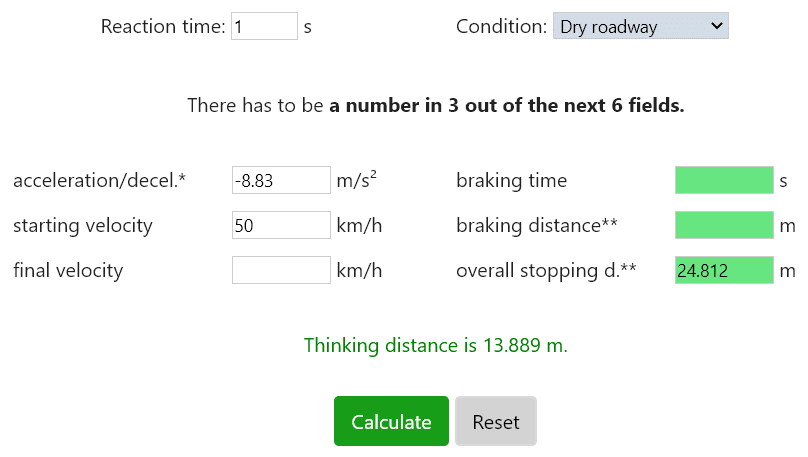To calculate stopping time, divide the initial velocity by the rate of deceleration. This gives you the time required to stop the vehicle.
Stopping time is an important calculation in determining the safety and efficiency of vehicle braking systems. By understanding how quickly a vehicle can come to a complete stop, drivers can make informed decisions to avoid accidents and maintain control on the road.
Calculating stopping time requires knowledge of the vehicle’s initial velocity and the rate at which it decelerates. This information can be used to assess the braking distance and ensure the vehicle can stop within a safe distance. Knowing how to calculate stopping time is crucial for both drivers and engineers involved in vehicle safety systems.

Credit: www.pw.live
Calculating Stopping Time
When it comes to road safety, understanding how to calculate stopping time is crucial for avoiding accidents and ensuring safe driving. Stopping time is the duration it takes for a vehicle to come to a complete halt from the moment the brakes are applied. It involves a combination of factors, including the vehicle’s initial speed, the braking force, and the frictional forces at play.
Basic Formula
The basic formula to calculate stopping time is:
Factors Affecting Stopping Time
Several factors can affect the stopping time of a vehicle, including:
- Speed of the vehicle
- Braking force applied
- Frictional forces between the tires and the road
- Reaction time of the driver
When calculating stopping time, it’s essential to consider these factors to ensure accurate results and to promote safe driving habits.
Mathematics Behind Stopping Time
To calculate stopping time, divide the vehicle’s speed by its deceleration rate. Understanding the math behind stopping time involves converting velocity units to meters per second for accurate results. This formula helps determine the time required to bring a moving object to a complete stop.
Stopping time is a crucial factor in various fields, particularly in understanding the dynamics of moving objects and ensuring safety measures in transportation. It involves the calculation of the time required for a moving object to come to a complete stop from its initial speed. This basic concept is rooted in physics and can be mathematically analyzed to determine the exact stopping time. The mathematics behind stopping time plays a significant role in numerous real-life applications and is essential for ensuring safety and efficiency in various domains.
Equations And Formulas Used
In order to calculate stopping time, several equations and formulas are used. One of the fundamental equations applied in this calculation is the kinematic equation, which relates the initial velocity, acceleration, and stopping distance. This equation is represented as:
Stopping distance (S) = (Initial velocity2) / (2 Deceleration)
Where the initial velocity is the speed at which the object is moving and deceleration is the rate at which the object is slowing down. Another crucial formula used is:
Stopping time (T) = Initial velocity / Deceleration
This straightforward formula allows for the calculation of the time required to bring a moving object to a complete stop, based on its initial velocity and the rate of deceleration.
Real-life Applications
The mathematics behind stopping time is not just a theoretical concept but has numerous real-life applications. In the automotive industry, understanding stopping time is crucial for designing effective braking systems and ensuring the safety of vehicles. Additionally, in the field of sports, particularly in track and field events, knowledge of stopping time helps in determining the necessary distance required for a runner to come to a stop safely. Moreover, in industrial settings, such as manufacturing and machinery operations, calculating stopping time is essential for ensuring worker safety and preventing accidents.
Understanding Deceleration
Definition And Concept
Deceleration is the rate at which an object slows down. It is the negative acceleration of an object in motion.
Calculating Deceleration
To calculate deceleration, you can use the formula: Deceleration = (final velocity – initial velocity) / time taken.

Credit: www.nagwa.com
Relation To Braking Distance
Calculating braking distance is an essential step in determining the stopping time of a vehicle. Braking distance refers to the distance a vehicle travels from the moment the brakes are applied until it comes to a complete stop. By understanding the relationship between braking distance and stopping time, we can gain valuable insights into the physics behind stopping a moving vehicle.
Calculating Braking Distance
To calculate the braking distance, we need to consider various factors such as initial speed, deceleration rate, and reaction time. Below is the formula to determine the braking distance:
Braking Distance = (Initial Speed^2) / (2 Deceleration)
This formula takes into account the initial speed of the vehicle and the deceleration rate, which is the rate at which the vehicle slows down. By using this formula, we can estimate the distance the vehicle will travel before coming to a stop under ideal conditions.
Influence On Stopping Time
The braking distance has a direct influence on the stopping time of a vehicle. The longer the braking distance, the more time it takes for the vehicle to come to a stop. This can be attributed to the fact that a greater distance needs to be covered before the vehicle’s motion is completely halted. Therefore, it is crucial to consider the braking distance when calculating the stopping time.
It is important to note that the braking distance can vary depending on several factors, such as road conditions, vehicle weight, and tire grip. These factors can affect the deceleration rate and, subsequently, the braking distance. Therefore, it is imperative to consider these variables for a more accurate estimation of the stopping time.
By understanding the relationship between braking distance and stopping time, we can appreciate the significance of calculating the braking distance accurately. This knowledge can contribute to safer driving practices and better vehicle control, ultimately reducing the risk of accidents.
Vehicle Safety And Stopping Time
Role Of Stopping Time In Safe Driving
Understanding the role of stopping time is crucial for safe driving. Stopping time is the key factor in determining the distance a vehicle needs to come to a complete stop in response to an emergency or sudden obstacle.
Technological Advances For Improving Stopping Time
Today, technological advancements have significantly improved stopping time through innovations such as anti-lock braking systems (ABS), traction control, and electronic stability control. These systems enhance a vehicle’s ability to decelerate quickly and efficiently, ultimately reducing stopping time and improving overall safety.
Practical Examples And Solutions
Understanding how to calculate stopping time is crucial, especially in driving scenarios. In this section, we will explore practical examples and solutions for applying stopping time calculations in a driving scenario and addressing variations in stopping time calculations.
Applying Stopping Time Calculations In Driving Scenario
When applying stopping time calculations in a driving scenario, it is essential to consider the various factors that can influence the stopping distance of a vehicle. Factors such as the initial speed of the vehicle, the braking force applied, and the coefficient of friction between the tires and the road surface all play a significant role in determining the stopping time. Let’s take a closer look at how these factors can be utilized in a practical example:
- Initial speed of the vehicle
- Braking force applied
- Coefficient of friction
Addressing Variations In Stopping Time Calculations
Addressing variations in stopping time calculations involves considering different scenarios that may affect the stopping time of a vehicle. Variations such as adverse weather conditions, road surface conditions, and vehicle weight can impact the stopping distance and time. To illustrate, let’s delve into a specific example:
- Adverse weather conditions
- Road surface conditions
- Vehicle weight

Credit: www.johannes-strommer.com
Frequently Asked Questions For How Do You Calculate Stopping Time?
How Do You Calculate Time Required To Stop?
To calculate the time required to stop, divide the speed by the deceleration.
What Is The Stopping Formula?
To calculate the stopping time, divide the speed by the deceleration rate. In other words, the stopping time is the speed divided by the rate of deceleration.
How Do You Calculate Stopping?
To calculate stopping time, divide speed by deceleration. This gives the time needed to stop. Remember to convert speed to correct units.
What Is The Formula For Stopping Distance?
The formula for stopping distance is: Initial velocity divided by the rate of deceleration. This gives you the time required to stop.
Conclusion
Calculating stopping time is crucial when ensuring safety on the road. By dividing speed by deceleration, you get the time needed to stop. Understanding this calculation helps prevent accidents and promotes responsible driving habits. Stay informed and apply these calculations for safer journeys ahead.
